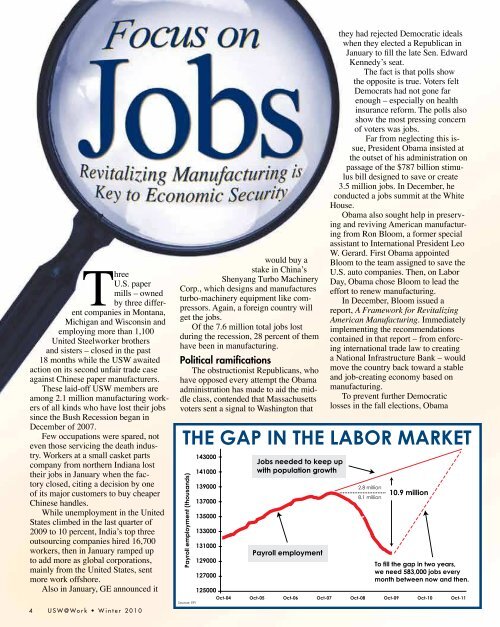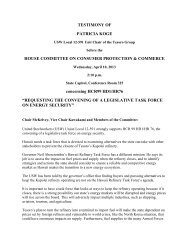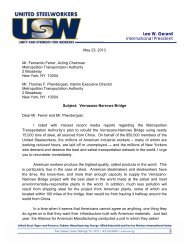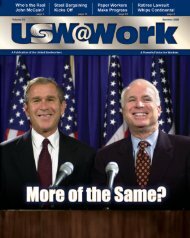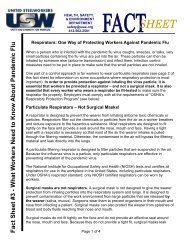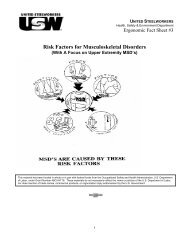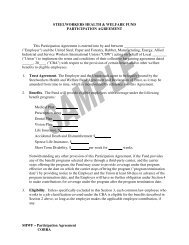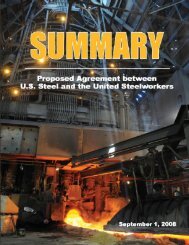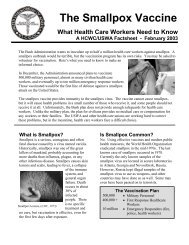Leo W. Gerard - United Steelworkers
Leo W. Gerard - United Steelworkers
Leo W. Gerard - United Steelworkers
You also want an ePaper? Increase the reach of your titles
YUMPU automatically turns print PDFs into web optimized ePapers that Google loves.
Three<br />
U.S. paper<br />
mills – owned<br />
by three different<br />
companies in Montana,<br />
Michigan and Wisconsin and<br />
employing more than 1,100<br />
<strong>United</strong> Steelworker brothers<br />
and sisters – closed in the past<br />
18 months while the USW awaited<br />
action on its second unfair trade case<br />
against Chinese paper manufacturers.<br />
These laid-off USW members are<br />
among 2.1 million manufacturing workers<br />
of all kinds who have lost their jobs<br />
since the Bush Recession began in<br />
December of 2007.<br />
Few occupations were spared, not<br />
even those servicing the death industry.<br />
Workers at a small casket parts<br />
company from northern Indiana lost<br />
their jobs in January when the factory<br />
closed, citing a decision by one<br />
of its major customers to buy cheaper<br />
Chinese handles.<br />
While unemployment in the <strong>United</strong><br />
States climbed in the last quarter of<br />
2009 to 10 percent, India’s top three<br />
outsourcing companies hired 16,700<br />
workers, then in January ramped up<br />
to add more as global corporations,<br />
mainly from the <strong>United</strong> States, sent<br />
more work offshore.<br />
Also in January, GE announced it<br />
would buy a<br />
stake in China’s<br />
Shenyang Turbo Machinery<br />
Corp., which designs and manufactures<br />
turbo-machinery equipment like compressors.<br />
Again, a foreign country will<br />
get the jobs.<br />
Of the 7.6 million total jobs lost<br />
during the recession, 28 percent of them<br />
have been in manufacturing.<br />
Political ramifications<br />
The obstructionist Republicans, who<br />
have opposed every attempt the Obama<br />
administration has made to aid the middle<br />
class, contended that Massachusetts<br />
voters sent a signal to Washington that<br />
they had rejected Democratic ideals<br />
when they elected a Republican in<br />
January to fill the late Sen. Edward<br />
Kennedy’s seat.<br />
The fact is that polls show<br />
the opposite is true. Voters felt<br />
Democrats had not gone far<br />
enough – especially on health<br />
insurance reform. The polls also<br />
show the most pressing concern<br />
of voters was jobs.<br />
Far from neglecting this issue,<br />
President Obama insisted at<br />
the outset of his administration on<br />
passage of the $787 billion stimulus<br />
bill designed to save or create<br />
3.5 million jobs. In December, he<br />
conducted a jobs summit at the White<br />
House.<br />
Obama also sought help in preserving<br />
and reviving American manufacturing<br />
from Ron Bloom, a former special<br />
assistant to International President <strong>Leo</strong><br />
W. <strong>Gerard</strong>. First Obama appointed<br />
Bloom to the team assigned to save the<br />
U.S. auto companies. Then, on Labor<br />
Day, Obama chose Bloom to lead the<br />
effort to renew manufacturing.<br />
In December, Bloom issued a<br />
report, A Framework for Revitalizing<br />
American Manufacturing. Immediately<br />
implementing the recommendations<br />
contained in that report – from enforcing<br />
international trade law to creating<br />
a National Infrastructure Bank – would<br />
move the country back toward a stable<br />
and job-creating economy based on<br />
manufacturing.<br />
To prevent further Democratic<br />
losses in the fall elections, Obama<br />
THE GAP IN THE LABOR MARKET<br />
Payroll employment (thousands)<br />
143000<br />
141000<br />
139000<br />
137000<br />
135000<br />
133000<br />
131000<br />
129000<br />
127000<br />
125000<br />
Oct-04<br />
Source: EPI<br />
Jobs needed to keep up<br />
with population growth<br />
Payroll employment<br />
Oct-05<br />
2.8 million<br />
8.1 million<br />
Oct-06 Oct-07 Oct-08 Oct-09<br />
10.9 million<br />
To fill the gap in two years,<br />
we need 583,000 jobs every<br />
month between now and then.<br />
Oct-10<br />
Oct-11<br />
must not only accomplish that, he must<br />
also re-connect with the apprehensive<br />
unemployed and persuade them that<br />
revitalizing American manufacturing is<br />
the correct path to economic security,<br />
for them and the <strong>United</strong> States.<br />
PRODUCTION JOBS<br />
PAY BETTER THAN<br />
SERVICE JOBS<br />
Average weekly wage of private sector jobs, 2009<br />
Service-providing: $610<br />
Goods-producing: $810<br />
Service jobs pay on average 75 cents for<br />
every dollar paid by a production job.<br />
Retail jobs pay 50 cents.<br />
AFL-CIO Political Director Karen<br />
Ackerman put it this way: “A massive<br />
reinvestment in creating jobs will be the<br />
decisive factor in the 2010 elections.”<br />
In recessions past, as Americans<br />
cracked open their wallets and began<br />
buying again, unemployment decreased.<br />
The cycle is simple: People buy, store<br />
shelves and warehouses empty, orders<br />
are placed and factories recall workers<br />
to meet those demands. Those workers,<br />
earning paychecks once again, resume<br />
spending. So supplies diminish once<br />
more and must be replenished with new<br />
factory orders.<br />
It could be different this time,<br />
though. That’s because when those orders<br />
are placed, the workers filling them<br />
are more likely to be overseas, in places<br />
like China or India – not in the <strong>United</strong><br />
States. So U.S. spending stimulates<br />
foreign economies.<br />
Richard McCormack, editor and<br />
publisher of Manufacturing and Technology<br />
News, described this phenomenon<br />
in a chapter of the book, Manufacturing<br />
A Better Future for America.<br />
“Even more alarming is the fact that<br />
without an industrial base, an increase<br />
in consumer demand, which historically<br />
pulled the country out of recession, will<br />
not put Americans back to work. Any<br />
additional consumer spending will only<br />
help workers making products<br />
overseas,” he wrote in the chapter<br />
entitled The Plight of American Manufacturing.<br />
McCormack notes that 40,000 U.S.<br />
manufacturing plants closed during the<br />
seven years ending in 2008. And there’s<br />
no outlook for revival<br />
on the horizon, not in<br />
high-tech or traditional<br />
manufacturing.<br />
McCormack cites<br />
two examples. Worldwide<br />
in 2008, 80<br />
major chemical plants<br />
costing more than $1<br />
billion were under<br />
construction or in<br />
planning. None was in<br />
the <strong>United</strong> States. The<br />
year before, in 2007,<br />
only two percent of<br />
new semiconductor<br />
fabrication plants<br />
were built in the<br />
<strong>United</strong> States.<br />
The very week the Democrats lost<br />
the Massachusetts Senate seat, the<br />
Obama administration renewed its focus<br />
on jobs and the economy – taking a cue<br />
from former President Bill Clinton’s<br />
successful 1992 campaign mantra: “It’s<br />
the economy, stupid.”<br />
Just three days after the loss, Obama<br />
conducted a town hall meeting on the<br />
economy in recession-battered Ohio.<br />
The economy and jobs were also a major<br />
theme in the President’s State of the<br />
Union address the following week.<br />
Obama’s proposals for jobs creation,<br />
including providing additional capital<br />
for small business and increasing<br />
exports, are all addressed in Bloom’s<br />
report.<br />
The report acknowledges the recent<br />
downturn “has been particularly painful<br />
for manufacturing companies, their<br />
workers and the communities that rely<br />
on them.”<br />
It is essentially an upbeat, forwardlooking<br />
document that says, “Many<br />
sectors of American manufacturing have<br />
the potential to enjoy significant growth<br />
and success. With the right policies,<br />
America can foster successful industries<br />
like biotechnology, wind power, nanotechnology,<br />
aerospace, next-generation<br />
automobiles, and perhaps more importantly<br />
the industries of the future that<br />
we do not even know about today.<br />
Source: Institute for America’s Future<br />
“Although the talent and hard work<br />
of America’s entrepreneurs, innovators<br />
and workers will drive these businesses,<br />
there is a critical role for sound government<br />
policy.”<br />
Do what it takes<br />
The government must do what it<br />
takes to promote a vibrant and thriving<br />
manufacturing sector by creating a<br />
competitive business climate, the report<br />
says. And it specifies ways the Obama<br />
administration has begun to do that<br />
and plans to do more, with programs it<br />
placed in the 2010 budget and policies it<br />
intends to implement.<br />
Among the goals it specifies that<br />
are crucial to <strong>Steelworkers</strong> is this one:<br />
“Improve the business climate, especially<br />
for manufacturing. . . We need<br />
legal, tax and regulatory regimes that<br />
promote American manufacturing and<br />
do not place an undue burden on those<br />
who wish to manufacture products in<br />
America.”<br />
Achieving another of the goals<br />
would be greatly appreciated by <strong>Steelworkers</strong><br />
whose factories – like those<br />
paper plants that closed in Montana,<br />
Michigan and Wisconsin – are threatened<br />
by unfair foreign competition:<br />
“Ensure market access and a level<br />
playing field. We must be sure that those<br />
who wish to sell the goods that they<br />
make in the U.S. into other countries<br />
have the market access they need and<br />
that those who sell domestically do not<br />
face unfair competition from advantaged<br />
foreign producers.”<br />
Democrats now must ensure the<br />
reports’ goals are implemented.<br />
THE U.S.-CHINA<br />
TRADE RELATIONSHIP<br />
$350<br />
325<br />
300<br />
275<br />
250<br />
225<br />
200<br />
175<br />
150<br />
125<br />
100<br />
75<br />
50<br />
25<br />
0<br />
2000<br />
U.S.-China trade in goods<br />
(in billions), 2000-2008<br />
2001<br />
2002<br />
U.S. IMPORTS<br />
2003<br />
2004<br />
2005<br />
U.S. EXPORTS<br />
2006<br />
2007<br />
2008<br />
Source: U.S. Department of Commerce, Bureau of Economic Analysis<br />
4 USW@Work • Winter 2010<br />
USW@Work • Winter 2010 5


